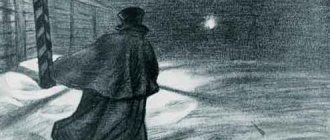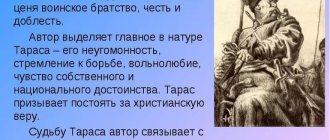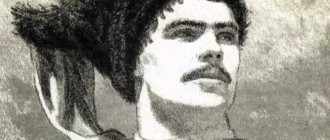- Essays
- On literature
- Gogol
- The Little Man in Gogol's story The Overcoat
We often encounter the image of the “little man” in Russian and foreign fiction. To us, Russian readers, brought up on examples of Russian literature, the image of the “little man” is painfully familiar. The first meeting with him happens in Gogol’s story “The Overcoat” by Nikolai Vasilyevich Gogol.
What is a “little man”? The answer is simple: this is a person of low social status and low origin, unremarkable and inconspicuous, not distinguished by outstanding abilities, weak-willed, humble and harmless.
This is exactly how we meet the main character of the story “The Overcoat,” the poor titular adviser Akaki Akakievich Bashmachkin. It is interesting to note that Nikolai Vasilyevich very skillfully approached the choice of the name of his literary hero: the word “Akaky” translated from Greek means “doing no evil.”
The author compares his hero to a fly to show how petty this man is. Akaki Akakievich has both positive and negative qualities. On the one hand, Bashmachkin is a person without interests and hobbies, without family and friends, which speaks of his certain isolation and self-restraint from the world around him. On the other hand, he is devoted to his work, performs it reverently and carefully, he is hardworking, patient and modest, does not pay attention to the insults of his colleagues, and does not start quarrels. For a person like Akaki Akakievich, the most insignificant thing can become the asset of his whole life.
The treasure of Bashmachkin’s life was a new overcoat, sewn for a holiday bonus. With the advent of the new thing, Bashmachkin’s character and the attitude of his colleagues towards him change. Their approval and admiration elevate Akaki Akakievich above himself, he becomes bolder, happier, more confident. But soon his happy mood changes, as his most expensive item, his overcoat, was stolen. This was a real tragedy for the poor titular councilor, who eventually fell ill and died. But even after death he cannot find peace, so he appears as a ghost on the Kalinkin Bridge and scares passers-by.
Thinking through the character of Akaki Akakievich, Gogol wanted to show readers that against the background of romantic heroes, bright, strong, contradictory personalities, there are realistic personalities: weak-willed, timid and even somewhat pitiful, but certainly deserving of human attention and empathy.
Essay Theme of the little man in Gogol's story The Overcoat
In the “St. Petersburg” story “The Overcoat,” written in 1842, Nikolai Vasilyevich Gogol raises the theme of the “little man.” This theme is constantly present in Russian fiction. Alexander Sergeevich Pushkin was the first author to address this issue; other authors continue this tradition.
Gogol considers the problem of a society in which a small person must exist. The author sharply criticizes the society of titular advisers who cannot accept Akaki Akakievich. The character’s phrase: “Don’t touch me, why are you offending me?” is a rhetorical question to the reader. The author draws attention to the fact that “little people” also have the right to a decent life and respect from people.
The day when Bashmachkin puts on his overcoat is the culmination of the work. At this moment he ceases to feel like a “little man”. His behavior and daily routine change completely. By this N. Gogol shows that Akaki Akakievich is the same person as others. He is no different, he experiences the same feelings, aspirations and grievances. He is no better and no worse than others.
The conflict between the little man and the world does not arise immediately, but only at the moment when Akaki Akakievich is left without his overcoat. The overcoat has long become more than clothing. It was a big part of the character himself. Having lost her, he begins to fight with society. And having not achieved victory during his lifetime, he continues it like a ghost.
The mystical side of the story is important for ending the conflict. Having received what he wanted, that is, an overcoat. This is a kind of justice, which is only possible in a fantasy world and is a utopia. On the other hand, in the finale, Gogol says that the immortal soul continues to desire revenge, and is only able to do it on its own.
Profession
Bashmachkin is not just a titular adviser, but an “eternal” titular adviser. The author of the story emphasizes that the central character has worked in this position all his life and is unlikely to be able to advance further up the career ladder. When Bashmachkin is offered not only to rewrite the papers, but also to change the face of the verbs, the main character cannot do this. He only has enough strength to rewrite something forever. It is worth noting that for Bashmachkin this is not a burden, but, on the contrary, a joy. Copying papers is the only activity that brings pleasure in the life of Akaki Akakievich. The hero does not understand the hardships of his life situation.
Essay The image of a little man in Gogol's story The Overcoat
“The Little Man” is one of the archetypes of Russian literature. The gallery of “little people” opens with a portrait of Samson Vyrin in Alexander Sergeevich Pushkin’s story “The Station Warden” (cycle “Belkin’s Tale”), continues with the image of Evgeniy from his own poem “The Bronze Horseman” and is firmly established in the tradition of realism inherited by Pushkin and his contemporaries.
Within the framework of the direction of realism, it is traditional to consider Nikolai Vasilyevich Gogol’s story “The Overcoat,” and the portrait of the main character of this work, Akaki Akakievich Bashmachkin, is included in the gallery of “little people” opened by Pushkin. This point of view is completely fair and is easily confirmed by the text.
What is characteristic of a “little man”? Low position in society, closeness (hiddenness) from the world, stinginess of feelings (but at the same time - the presence of an object of love and care), suffering during life (usually a single act that influences the further fate of the hero), and, most likely, death ( often - precisely from life’s suffering).
All this can be seen in “The Overcoat”. Bashmachkin is a petty official, a copyist of papers, who lives poorly and ascetically. He has no friends - he only has colleagues who become interested in him only with the acquisition of an overcoat (but not before and not on his own). Bashmachkin also has something that he loves and cherishes. Unlike his daughter - in the case of Vyrin - and Parasha, his beloved girl - in the case of Evgeniy - for Akaki Akakievich it is letters in documents and an overcoat, the dream of which he lives.
As in other cases, the suffering of the “little man” is in one way or another connected with the object of his affection. So, Vyrin loses his daughter, Evgeniy hurries to Parasha and is afraid that the flood will harm her. In a dark alley, two people steal Bashmachkin’s favorite overcoat - literally the next day after the purchase. Suffering and experience (after a certain period of time) is followed by the death of the main character.
It is worth noting that very often the status of the “little man” is emphasized by his position in the hierarchy of power; To “reveal” this position of his, the author places the hero in a situation where he is opposed to someone who is superior to him in his power. Let's consider, again, Vyrin and Evgeniy - the first finds himself on the threshold of his daughter's house, but entry there is closed to him, as a poor, ignorant and uninvited guest; the second turns out to be directly opposed to Emperor Peter (and, although he shakes his fist at him, he understands all his powerlessness and insignificance).
Bashmachkin is faced with a hierarchy of positions when his attempts to gain the attention of an official who could help his trouble fail.
It is also interesting to note that in one fundamental point Gogol departs from the previous tradition. The ending of the story of his hero becomes a certain triumph and superiority - the spirit of Bashmachkin tears off the warm overcoats of officials and terrifies those who encounter him. It is clear that this cannot be called a triumph of the “little man” in the full sense of the word; but, of course, this feels, if not a denial of Pushkin’s point of view, then at least a polemic with him and the prevailing understanding of the “little man.”
The story teaches kindness, patience, and forbearance; however, Gogol does not choose, as in his later works, an edifying tone and does not shy away from irony in the depiction of his “little man.”
Other works: ← Landowners in the poem Dead Souls of Gogol ↑ GogolGogol's Tale Overcoat →
The great tragedy of a little man in the story “The Overcoat”
It is no coincidence that the theme of the “little man” in “The Overcoat” is raised by Gogol. Typification of heroes is one of the main features of the realistic method of creativity, and the image of the “little man” has become traditional for Russian realism. Alexander Pushkin (Samson Vyrin from The Station Agent) is rightfully considered its creator. Both authors see hidden treasures of the soul even in the most prosaic character. “Little people” do not show off love, self-denial or devotion to an ideal for everyone to see, but keep it deep in their hearts. A short-sighted society does not see this, clearly neglecting them, considering as nonentities those who are actually head and shoulders above the rest.
The conflict in Gogol’s story “The Overcoat” is the great tragedy of a little man whose only value was taken away. But the main problem is that no one sympathizes with the hero; he does not find support from those around him. His misfortune is only aggravated by indifference or ridicule. On the one hand, the author protests against a world that turns a person into Akaki Akakievich, who has found the meaning of life in things. He sharply criticizes those who “taunted and made jokes to their heart’s content” over the “eternal titular advisers.” Such downtrodden and broken people should not exist at all. On the other hand, Gogol is a realist, he understands that they exist and will exist, so he calls for at least paying attention to the unfortunate Bashmachkins, to prevent a tragic outcome to their fate.
The image of Bashmachkin is not at all embellished by the author: the interests of Akaki Akakiechiv are wretched. His ideal and ultimate dream is an overcoat. The symbol of the overcoat is, of course, clear: protection from a cold, hostile world, the only joy and friend of life. But the hero goes to the goal through pain, limiting himself in everything. He refuses dinners, a candle in the evenings, and washing clothes with a laundress, just to save up for the coveted purchase. Many see in him the features of Saint Akakios of Sinai, which explains the official’s unusual name. Humility, resignation, self-sacrifice - this is what the heroes of the life and Gogol's story have in common.
Going through trials, the human spirit is strengthened.
So Bashmachkin becomes stronger, bold thoughts and far-reaching plans appear in his head: “should we put a marten on the collar?” The day he received his overcoat became a real holiday of emancipation for the hero. The usual routine course of his life was finally disrupted: “He had lunch cheerfully and after dinner he didn’t write anything, no papers, but just sat on his bed for a little while until it got dark.” Then he went to a kind of new party and drank two glasses of champagne. But all the author’s irony gives way to indignation when the hero is deprived of his property. The suffering experienced by Bashmachkin after the loss of his overcoat is comparable to grief over the death of a loved one. Akaki Akakievich seeks protection from the state, but his request only angered the “significant person.” The great tragedy lies in the fact that the world is indifferent to the grief of a little person. The overcoat warmed and protected the hero, and people only mocked him or did not pay their precious attention to his fate. The cold St. Petersburg climate is associated with an atmosphere in a team, where even a warm heart after a while is either covered with frost or stops beating. Interesting? Save it on your wall!
The theme of the little man in Gogol's story "The Overcoat"
(384 words) Akaki Akakievich Bashmachkin is the main character of the story by N.V. Gogol's "The Overcoat". This character is an image of a “little man”, whom the author depicted using the technique of typification.
Everything that surrounds Akaki seems to hint at his difficult social and financial situation. The position of titular adviser in the St. Petersburg department does not bring him much income, since he mainly rewrites papers. This activity gives Bashmachkin considerable pleasure; he does not want to engage in a new type of activity (he refuses the papers proposed by the director for editing).
Akakiy Akakievich’s clothes also seemed to be all worn out by life. Only the frost made him think that the old overcoat was no longer suitable and he should buy a new one. But since Akaki does not have the money to buy it, he begins to save on himself.
The writer illustrates this situation in order to show the reader that the main character sets his “minor” goal to acquire a new thing. It is when a substitution of values occurs that a person gradually begins to lose the meaning of his existence, believing that he himself is less worthy of respect than objects of material well-being.
And so it happened. Akaki Akakievich begins to refuse candles and tea in the evenings; at home, “in order not to wear out his linen,” he wears a robe over his naked body. However, these deprivations do not bother him. Bashmachkin is even happy that he managed to buy an overcoat, for the sake of which he had to make his diet more meager, and completely forget about convenience for a while.
Many began to respect him when they saw him in his new overcoat, some even invited him to visit. Gogol uses the technique of contrast here to contrast the attitude of others towards Akaki before and after the purchase of the overcoat. Until this moment, many had even mocked him, but now the titular adviser seemed to have become a higher rank in their eyes.
Unfortunately, these happy moments did not last long. Soon after the holiday to which Bashmachkin was invited, a misfortune happened (his overcoat was torn right from his shoulders). Even from a “significant person” Akaki could not get help.
The episode in which it becomes clear how “petty” Bashmachkin’s goal was is his death from fever. This illness was caused by worries about a lost overcoat, which seemed to be the soul of the main character. Now that she is not with him, Akakiy Bashmachkin seems to have no reason to live (that’s why he dies).
Since during his lifetime Akaki did not have time to enjoy his expensive thing and return it to himself, he becomes a ghost, tearing off people's greatcoats in the same way as they once did to him. Even the “significant person” finally came to his senses and began to be more respectful of those below him in social status.
Author: Anastasia Kutkovetskaya
Interesting? Save it on your wall!








